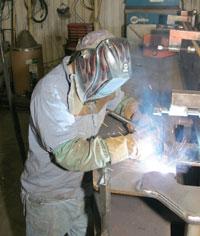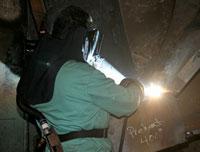Marketing Segment Manager - Oil and Gas
- FMA
- The Fabricator
- FABTECH
- Canadian Metalworking
Categories
- Additive Manufacturing
- Aluminum Welding
- Arc Welding
- Assembly and Joining
- Automation and Robotics
- Bending and Forming
- Consumables
- Cutting and Weld Prep
- Electric Vehicles
- En Español
- Finishing
- Hydroforming
- Laser Cutting
- Laser Welding
- Machining
- Manufacturing Software
- Materials Handling
- Metals/Materials
- Oxyfuel Cutting
- Plasma Cutting
- Power Tools
- Punching and Other Holemaking
- Roll Forming
- Safety
- Sawing
- Shearing
- Shop Management
- Testing and Measuring
- Tube and Pipe Fabrication
- Tube and Pipe Production
- Waterjet Cutting
Industry Directory
Webcasts
Podcasts
FAB 40
Advertise
Subscribe
Account Login
Search
Metallurgy for welders
Addressing 4 key issues
- By Keith Packard
- Updated January 29, 2019
- May 25, 2012
- Article
- Metals/Materials

Metallurgy affects the way you approach applications every day, as well as the equipment and filler metal you use. Once you recognize a material’s weldability and the way it reacts to heating and cooling, you’ll have a greater chance of successfully completing the job.
Webster’s dictionary defines metallurgy broadly as “the science and technology of metals.” But in practical terms, metallurgy affects the way you approach welding applications, the equipment and filler metal you use, and the challenges you face throughout the welding process. Not surprisingly, the metallurgical properties of a piece of metal—its mechanical strengths and chemistry—alsodetermine how well, or if, it can be welded. From carbon and sulfur levels to tensile strength and the manner in which a given material is processed or reacts to heating and cooling, each element factors into the success or failure of a welding application.
When welding any material, your goal is to resist changing its microstructure and to preserve its mechanical and chemical properties. To do this, every welder should consider these key metallurgical issues before starting a job.
1. Is It Weldable?
It’s critical that you know as much as possible about the material before striking an arc. Ask yourself, Is it weldable? Weldability refers to the ability of two pieces of material to be welded together and still maintain the desired mechanical and chemical properties for the application. A few conditions can affect a material’s weldability, and there are a few things you must be ableto do to ensure a successful operation.
Identify the Material. Figuring out the weldability of materials can be difficult at times. You may be required to weld a part without knowing what material it is. Or you might receive a part from a customer who has not specified that information. Chemistry tests and spark tests are recommended to identify the metallurgy of the material before proceeding with the weldingprocess.
Understand Special Welding Requirements. Not all materials lend themselves to being welded, and some require special precautions before, during, or after the process. For example, materials such as resulfurized steels have high levels of carbon, sulfur, and phosphorus, making them notoriously difficult to weld because they are highly susceptible to cracking. Many types ofchrome-moly steel (4000, 4100, and 4300 series) also have higher carbon and chrome levels than carbon steels and are similarly prone to cracking if you don’t follow proper welding procedures. These include selecting the appropriate filler metal and employing preheat and postweld heat treatment (PWHT) when necessary.
Evaluate Joint Design and Preparation. In some cases, the joint design may affect your ability to access the joint, which in turn affects the material’s weldability by limiting the opportunity to perform a clean weld with proper penetration. Weldability can be affected further by joint preparation. For example, materials that are carbon arc gouged can accumulate residualcarbon on the surface that can lead to cracking. Or a piece of material that has been machined may have residual machining fluid that could generate porosity. Paint, oil, and grease can also affect a material’s weldability, so the material should always be properly cleaned prior to welding.
Given these possible conditions, you must make the proper accommodations to ensure that the weld can still be made successfully. Cleaning materials properly and implementing proper weld procedures can help address issues with weldability. Similarly, selecting filler metals that are not crack-susceptible and have good ductility or toughness properties (depending on the needs of the givenmaterial) is also important.
2. Controlling Heat
Heat input during welding can affect the mechanical properties of a material adversely. When a weld joint is produced with an excessively low heat input, it dissipates the heat quickly, causing internal stress in both the weld and the base material. Similar stresses can cause the two pieces of material to pull apart after cooling. Both situations, singularly or in combination, can lead to cracking.
Cracking of this nature is quite common in chrome-moly steels with high chrome and carbon levels, such as 4000 series materials; however, it can occur in most any material type.
High heat input can also lead to distortion, which typically occurs in thin materials and those that are highly restrained because of a particular weldment design. The localized heat input in the weld joint causes the material to change shape when it cools. You can resolve this problem by clamping the part and prebending it in the opposite direction, or by controlling the bead sequence. Aseries of small stringer beads also can help minimize distortion because it reduces the amount of heat going into the weldment. In some materials like quenched and tempered steels, high heat input can cause the material to soften and weaken.

Preheating is key in controlling heat input and preventing rapid cooling. Always follow the proper PWHT recommendation for your application.
For all of these reasons, it is critical for you to monitor how much heat you are putting into the weld joint during the welding process and control it accordingly. The equation you can use to determine heat input is:
Amps × Volts × 60/ Travel Speed (in inches per minute) = Kilojoules per Inch.
You can also use a temper bead effect to help refine the microstructure of the grains in the weld and provide it with good strength. To create a temper bead, add two to three extra weld beads on top of a weldment, which causes extra heat to go into the weld bead below, thereby tempering it.
Preheating is another option. Bringing the material up to a specified temperature before welding can help reduce the residual stresses in the material and prevent it from cooling too quickly, which causes changes to the material’s microstructure that lead to cracking, distortion, and softening. Monitoring and controlling interpass temperatures on multipass welds is also critical, as isimplementing slow cooling procedures.
3. Preventing Rapid Cooling
In conjunction with controlling heat input, you also need to control the rate at which the weld cools. Uncontrolled cooling can lead to many problems both within the weld and in the base material. Rapid cooling produces smaller, finer grains in the metal's microstructure, while slow cooling produces larger, coarser grains. Excessively high or low cooling rates decrease the metals' crack resistance.
Rapid cooling most often occurs in tandem with low-heat-input conditions, as discussed previously, but it can also happen without them. For example, if you weld a thick piece of material without preheating, it becomes a large heat sink. Even though it may not heat up very much, it sucks the heat out when the weld is complete, which causes rapid cooling within the material.
Rapid cooling may lead to distortion, increased hardness, and decreased ductility. In some cases, it can also induce hydrogen cracking, which is often referred to as cold cracking or heat-affected-zone (HAZ) cracking. This type of defect begins in the base metal and passes transversely into the weld as it progresses. It is the result of both residual stresses and thepresence of diffusible hydrogen in the weld, and changes in the microstructure of the material.
To prevent rapid cooling, preheat the base metal and control interpass temperatures on multipass welding applications. Preheating offers the additional benefit of allowing the arc to penetrate the weld joint more readily. You can also perform PWHT, holding the finished weld at a prescribed temperature for a period of time via a process like induction or furnace heating. PWHT helps relieveresidual stresses and it drives diffusible hydrogen from the weldment to help minimize the chances of cracking.
4. Matching Filler Metals
Selecting the appropriate filler metal can play a role in overcoming challenges associated with a material’s chemical and mechanical properties. As a rule, most applications require “matching” filler metal tensile or yield strength to that of the base material. The word matching is quoted here because the two strengths may not be exact.
In some cases, it may be desirable to “undermatch” the strength of the filler metal to the base material. Undermatching can be beneficial because it helps increase toughness and ductility and may help minimize the residual stresses in the weldment.
While there are additional metallurgical considerations that you should become aware of, determining weldability, controlling heat, preventing rapid cooling, and matching filler metals are the main ones. To prevent changing the microstructure of a weld and the materials it holds together, always be mindful of prescribed procedures, and know what type of material you are welding beforebeginning any process.
About the Author
Keith Packard
101 Trade Square East
Troy, OH 45373
937-332-5435
About the Publication
Related Companies
subscribe now

The Welder, formerly known as Practical Welding Today, is a showcase of the real people who make the products we use and work with every day. This magazine has served the welding community in North America well for more than 20 years.
start your free subscription- Stay connected from anywhere

Easily access valuable industry resources now with full access to the digital edition of The Fabricator.

Easily access valuable industry resources now with full access to the digital edition of The Welder.

Easily access valuable industry resources now with full access to the digital edition of The Tube and Pipe Journal.
- Podcasting
- Podcast:
- The Fabricator Podcast
- Published:
- 04/16/2024
- Running Time:
- 63:29
In this episode of The Fabricator Podcast, Caleb Chamberlain, co-founder and CEO of OSH Cut, discusses his company’s...
- Industry Events
16th Annual Safety Conference
- April 30 - May 1, 2024
- Elgin,
Pipe and Tube Conference
- May 21 - 22, 2024
- Omaha, NE
World-Class Roll Forming Workshop
- June 5 - 6, 2024
- Louisville, KY
Advanced Laser Application Workshop
- June 25 - 27, 2024
- Novi, MI































